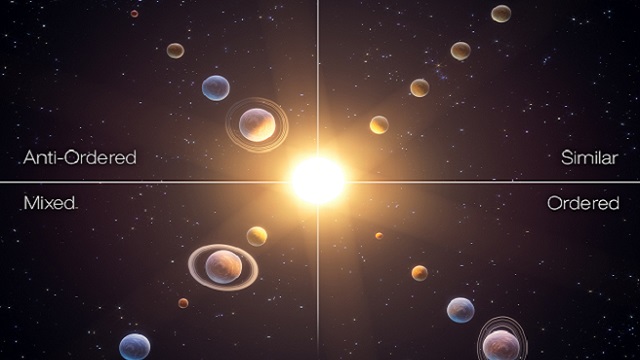
Artist impression of the four classes of planetary system architecture © NCCR PlanetS, Illustration: Tobias Stierli
Scientists have determined that there are four different types of solar systems in the universe and of these, our own – System Sol – falls into the rarest category. Researchers from the National Centre of Competence in Research PlanetS (NCCR PlanetS) and the Universities of Geneva and Bern in Switzerland have established four categories for the way in which planets orbit their respective stars: Ordered, Anti-Ordered, Mixed and Similar. System Sol is classified as “Ordered.”
The scientists defined Ordered planetary systems as those where the mass of planets tends to increase with distance from the star – just as in our solar system. When the opposite is the case and the mass of the planets roughly decreases with their distance from the star it is called an Anti-Ordered system. A Mixed system is where the masses of the planets have no order to them.
A Similar planetary systems is one where the masses of neighboring planets are similar to one another other and do not have great differences in mass.
Will you offer us a hand? Every gift, regardless of size, fuels our future.
Your critical contribution enables us to maintain our independence from shareholders or wealthy owners, allowing us to keep up reporting without bias. It means we can continue to make Jewish Business News available to everyone.
You can support us for as little as $1 via PayPal at office@jewishbusinessnews.com.
Thank you.
Study co-author Yann Alibert, Professor of Planetary Science at the University of Bern and the NCCR PlanetS, said, “Now, for the first time, we have a tool to study planetary systems as a whole and compare them with other systems.”
“More than a decade ago, astronomers noticed, based on observations with the then groundbreaking Kepler telescope, that planets in other systems usually resemble their respective neighbors in size and mass – like peas in a pod,” says study lead author Lokesh Mishra, researcher at the University of Bern and Geneva, as well as the NCCR PlanetS
“Our results show that ‘similar’ planetary systems are the most common type of architecture. About eight out of ten planetary systems around stars visible in the night sky have a ‘similar’ architecture,” says Mishra. “This also explains why evidence of this architecture was found in the first few months of the Kepler mission.”
The scientists were, however, surprised that the “Ordered” architecture – the one that also includes our solar system – seems to be the rarest class.
Established by the Swiss National Science Foundation in June 2014, the NCCR PlanetS brings together researchers from the Universities of Berne (Leading House), Geneva (co-Leading House), and Zürich as well as of the ETHs Zürich and Lausanne. It is structured in research projects and platforms which provide the structuring elements of the NCCR.



